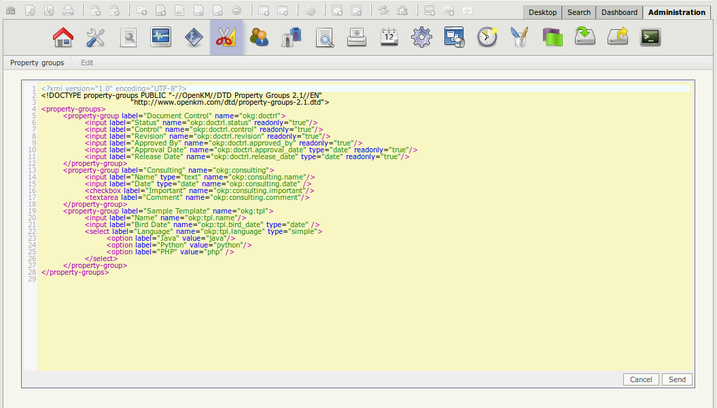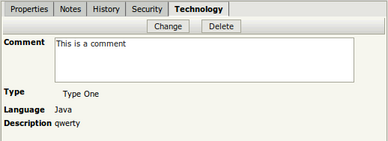Difference between revisions of "Property Groups"
(Updated to OpenKM 4.0 format.) |
|||
| (8 intermediate revisions by 2 users not shown) | |||
| Line 1: | Line 1: | ||
| − | This is easy and powerful for building custom properties. You can | + | This is an easy and powerful way for building custom properties. You can use this feature to add information to documents. For example, if you store the invoices in a folder you can add a property group to set the client name and the quantity. You will see this important data without opening the documents. Also you can search by these custom properties later. |
| − | + | {{Advice|Refer to [[Property Groups definition]] where you can see the new way to describe Property Groups.}} | |
| − | * | + | By default sample Property Groups are bundle with your OpenKM installation. If you don't see these Property Groups, click in the '''Register property groups''' button to register them. |
| − | * | + | |
| − | + | ||
| − | + | [[File:Okm admin 011.jpeg|717px|center]] | |
| − | To try this | + | |
| + | |||
| + | You can also add, remove or modify these Property Groups editing the '''PropertyGroups.xml''' definition file with your preferred editor or directly from OpenKM Administration if you click in the '''Edit property groups''' button. Once edited you need to register them again. | ||
| + | |||
| + | |||
| + | [[File:Edit Property Group.png|717px|center]] | ||
| + | |||
| + | |||
| + | The users can assign a property group to a document using these toolbar buttons: | ||
| + | |||
| + | * Add property group → [[File:Add_property_group.gif]] | ||
| + | * Remove property group → [[File:Remove_property_group.gif]] | ||
| + | |||
| + | And the properties will be shown in the information area. You can edit the values of the properties using the Change button. Then you can change these values. You can also remove a property group from a document by clicking the Delete button. | ||
| + | |||
| + | |||
| + | [[File:Okm 003.png|388px|center]] | ||
| + | |||
| + | === OpenKM 5.1 === | ||
| + | To try this, login as okmAdmin and go to Administration → Utilities → Register property groups. Set full path with the location of the local file ''PropertyGroups.cnd'' and click on the register button. The properties will be registered. | ||
| Line 13: | Line 32: | ||
{{Warning|'''REGISTERED GROUPS CANNOT NOT BE UNREGISTERED'''. They can always be updated but they cannot be deleted after registration !!! Try it out on a test installation first.}} | {{Warning|'''REGISTERED GROUPS CANNOT NOT BE UNREGISTERED'''. They can always be updated but they cannot be deleted after registration !!! Try it out on a test installation first.}} | ||
| + | |||
| + | === OpenKM 4.0 and older === | ||
| + | You need to create some file, for example '''PropertyGroup.cnd''' and insert some values in two other files '''PropertyGroupBundle.properties''' and '''PropertyGroupValues.properties'''. | ||
| + | |||
| + | * $JBOSS_HOME/PropertyGroup.cnd | ||
| + | * $JBOSS_HOME/PropertyGroupBundle.properties | ||
| + | * $JBOSS_HOME/PropertyGroupValues.properties | ||
About files: | About files: | ||
| Line 33: | Line 59: | ||
</source> | </source> | ||
| − | * '''PropertyGroupValues.properties''': In this file you can see the | + | * '''PropertyGroupValues.properties''': In this file you can see the property values, for example for parameter (okp\:technology.type=4,one,two,three) has 3 values (one, two, three) the first number indicates the order, the second one the type (1 = list, 2 = input, 3 = select multiple, 4 = Text area) |
<source lang="java"> | <source lang="java"> | ||
| Line 44: | Line 70: | ||
</source> | </source> | ||
| − | * '''PropertyGroupBundle.properties''': This file contains general translations for each value | + | * '''PropertyGroupBundle.properties''': This file contains general translations for each value. You can have more files for each language like PropertyGroupBundle_ES.properties etc. |
<source lang="java"> | <source lang="java"> | ||
| Line 67: | Line 93: | ||
</source> | </source> | ||
| − | OpenKM tries to find the correct language in your property files. If it does not exist | + | OpenKM tries to find the correct language in your property files. If it does not exist it uses ''PropertyBundle.properties''. |
| − | |||
| − | |||
| − | |||
| − | |||
| − | |||
| − | |||
| − | |||
| − | |||
| − | |||
| − | |||
[[Category: Installation Guide]] | [[Category: Installation Guide]] | ||
Latest revision as of 10:57, 3 January 2013
This is an easy and powerful way for building custom properties. You can use this feature to add information to documents. For example, if you store the invoices in a folder you can add a property group to set the client name and the quantity. You will see this important data without opening the documents. Also you can search by these custom properties later.
| Refer to Property Groups definition where you can see the new way to describe Property Groups. |
By default sample Property Groups are bundle with your OpenKM installation. If you don't see these Property Groups, click in the Register property groups button to register them.
You can also add, remove or modify these Property Groups editing the PropertyGroups.xml definition file with your preferred editor or directly from OpenKM Administration if you click in the Edit property groups button. Once edited you need to register them again.
The users can assign a property group to a document using these toolbar buttons:
And the properties will be shown in the information area. You can edit the values of the properties using the Change button. Then you can change these values. You can also remove a property group from a document by clicking the Delete button.
OpenKM 5.1
To try this, login as okmAdmin and go to Administration → Utilities → Register property groups. Set full path with the location of the local file PropertyGroups.cnd and click on the register button. The properties will be registered.
| REGISTERED GROUPS CANNOT NOT BE UNREGISTERED. They can always be updated but they cannot be deleted after registration !!! Try it out on a test installation first. |
OpenKM 4.0 and older
You need to create some file, for example PropertyGroup.cnd and insert some values in two other files PropertyGroupBundle.properties and PropertyGroupValues.properties.
- $JBOSS_HOME/PropertyGroup.cnd
- $JBOSS_HOME/PropertyGroupBundle.properties
- $JBOSS_HOME/PropertyGroupValues.properties
About files:
- PropertyGroup.cnd: There are general definitions on each parameter (for example the parameter okp:technology.type)
<okm = 'http://www.openkm.org/1.0'>
<okg = 'http://www.openkm.org/group/1.0'>
<okp = 'http://www.openkm.org/group/property/1.0'>
[okg:technology] mixin
- okp:technology.type (string) = '' multiple autocreated
- okp:technology.language (string) = '' autocreated
- okp:technology.description (string) = '' autocreated
- okp:technology.comment (string) = '' autocreated
[okg:consulting] mixin
- okp:consulting.type (string) = '' autocreated
- okp:consulting.comment (string) = '' autocreated
- PropertyGroupValues.properties: In this file you can see the property values, for example for parameter (okp\:technology.type=4,one,two,three) has 3 values (one, two, three) the first number indicates the order, the second one the type (1 = list, 2 = input, 3 = select multiple, 4 = Text area)
okp\:technology.type=1,4,one,two,three
okp\:technology.language=2,3,java,c,c#,c++,python
okp\:technology.description=3,1
okp\:technology.comment=4,2
okp\:consulting.type=1,3,one,two,three
okp\:consulting.comment=2,2
- PropertyGroupBundle.properties: This file contains general translations for each value. You can have more files for each language like PropertyGroupBundle_ES.properties etc.
okg\:technology=Tecnology
okp\:technology.type=Type
okp\:technology.type.one=Type One
okp\:technology.type.two=Type Two
okp\:technology.type.three=Type Three
okp\:technology.language=Language
okp\:technology.language.java=Java
okp\:technology.language.c=C
okp\:technology.language.c++=C++
okp\:technology.language.python=Python
okp\:tecnology.description=Description
okp\:technology.comment=Comment
okg\:consulting=Consulting
okp\:consulting.type=Type
okp\:consulting.type.one=Type One
okp\:consulting.type.two=Type Two
okp\:consulting.type.three=Type Three
okp\:consulting.comment=Comment
OpenKM tries to find the correct language in your property files. If it does not exist it uses PropertyBundle.properties.



